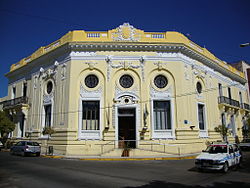Top Qs
Timeline
Chat
Perspective
San Luis, Argentina
City in San Luis, Argentina From Wikipedia, the free encyclopedia
Remove ads
San Luis (Spanish pronunciation: [ˈsan ˈlwis]) is the capital city of San Luis Province in the Cuyo region of Argentina. It is also the seat of the Juan Martín de Pueyrredón Department.
This article needs additional citations for verification. (February 2022) |
Remove ads
City information
Points of interest in the city include the Park of the Nations, the neoclassical cathedral, a number of museums, including the Dora Ochoa De Masramón Provincial Museum, and examples of colonial architecture. A number of landmarks honour the Argentine War of Independence, as well. Independence Park features an equestrian monument to General José de San Martín, liberator of Argentina, Chile and Peru. Nearby Pringles Plaza honours Colonel Juan Pascual Pringles, one of San Martín's chief adjutants and, briefly, Governor of San Luis Province.
Fishing in the nearby Lake Potrero de los Funes, and other locations, is also popular. The Sierra de las Quijadas National Park is located 122 km (76 mi) from the city.
Solar Power
Located just outside the city is the Solar power park Caldenes del Oeste.[1]
Remove ads
Transport
National Route 7 connects San Luis to Mendoza, 255 km (158 mi) to the west, and Buenos Aires, 791 km (492 mi) to the east. San Luis Airport is located less than 3.2 km (2 miles) north of the city centre, and has regular flights to Buenos Aires.
History
San Luis was founded on August 25, 1594, by Luis Jufré de Loaysa y Meneses. The settlement was later abandoned, and was reestablished in 1632 by Martín García Oñez de Loyola as San Luis de Loyola Nueva Medina de Río Seco.
By the end of the 19th century, San Luis had 7,000 inhabitants, and in 1882 the Argentine Great Western Railway reached the city on its way to Chile. The following year, work began on the cathedral. The Governor's Executive Building, designed in French renaissance architecture, was completed in 1911. The city's population reached 40,000 in 1960, and grew rapidly afterwards, when light industry and growing numbers of retirees began to migrate to the area; at the 2001 census [INDEC], its population was 153,322.
Because the city is located at the part of the Sierras Grandes known as Punta de los Venados (Deer Point), the inhabitants of the city are called puntanos.
Geography
Summarize
Perspective
San Luis lies at the foot of the Sierras Grandes, along the northern bank of the Chorrillos River, and is set on a dry pampas plateau, around 730 m (2,400 ft) above sea level.
Climate
San Luis has a humid subtropical climate (Cwa, according to the Köppen climate classification) and it closely borders a semi-arid climate (BSk). Summers are hot and humid, and winters are cool and dry, with temperatures falling below 0 °C (32.0 °F) sometimes and snowfalls can occur occasionally. The hottest month, January, has an average temperature of 24.0 °C (75.2 °F), and the coldest month, July, has an average of 8.9 °C (48.0 °F). The annual average temperature is 17.4 °C (63.3 °F).
Remove ads
Gallery
- City Hall
- Former railway station (1907), today a cultural centre
- San Luis National College
- Plaza Pringles
Notable people
|
|
|
Remove ads
References
External links
Wikiwand - on
Seamless Wikipedia browsing. On steroids.
Remove ads






